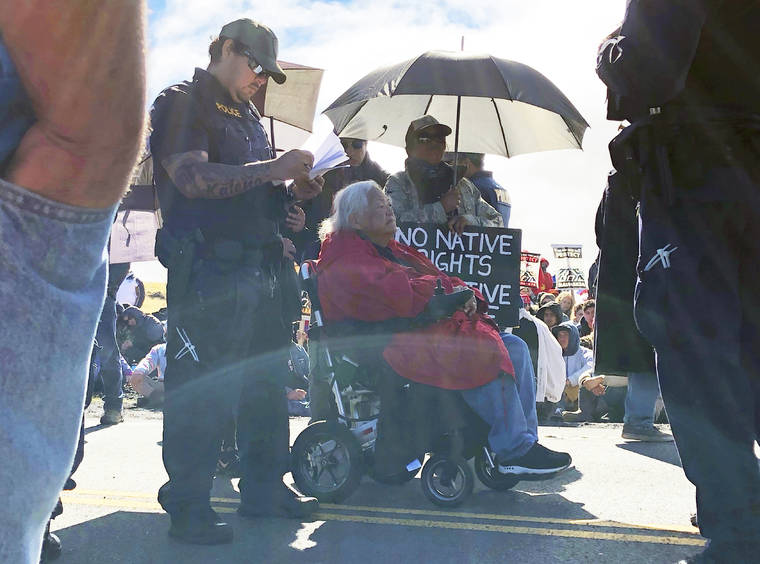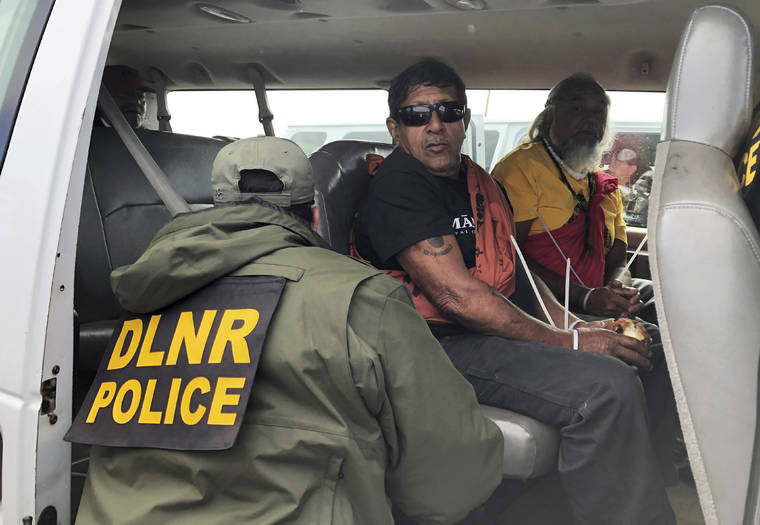HONOLULU — Police arrested elderly protesters, some using wheelchairs and canes, as they blocked a road Wednesday to Hawaii’s highest peak to try to stop construction of a giant telescope on land some Native Hawaiians consider sacred.
About 2,000 people were at the intersection of the highway and the road that leads to Mauna Kea’s summit and the new construction site, Hawaii County Managing Director Wil Okabe said.
Protest leader Kealoha Pisciotta told The Associated Press that police took away about 30 elders who were prepared to be arrested. State spokesman Dan Dennison said he could not provide the number of people arrested or what charges would be filed.
“They’re taking our kupuna,” said Pisciotta using the Hawaiian word for elders and sobbing. Around her, people sang “Hawaii Aloha,” a Hawaiian song that’s common at events.
Some of the elders used canes and strollers to walk, while others were taken in wheelchairs to police vans. Those who could walk on their own were led away with their hands in zip ties.
One woman being arrested did a nose-to-nose greeting, called honi, with an officer before he walked her to a van, Pisciotta said. Another man chanted as an officer took him away.
Walter Ritte, one of the protesters arrested, said he was driven down the mountain, given a citation and released.
He’s back at the base of Mauna Kea, and says he won’t block the road again today.
“But tomorrow is another day and we’re free to do whatever we want tomorrow, Ritte said.”
The $1.4 billion Thirty Meter Telescope is expected to be one of the world’s most advanced. Native Hawaiian protesters and other opponents of the telescope say they are concerned construction will desecrate and damage the mountain. The project has been delayed by years of legal battles and demonstrations. Last year, the Hawaii Supreme Court ruled that telescope officials had legally obtained a permit, clearing the way for construction to begin.
Kaho’okahi Kanuha, another protest leader, told reporters that efforts to stop the telescope were about protecting Hawaii’s indigenous people.
“This is about our right to exist,” he said. “We fight and resist and we stand, or we disappear forever.”
Other Native Hawaiians say they don’t believe the project will desecrate Mauna Kea. Most of the cultural practices on the mountain take place away from the summit, said Annette Reyes, a Native Hawaiian from the Big Island.
“It’s going to be out of sight, out of mind,” she said.
Authorities closed the road to the top of the mountain Monday to allow construction to begin, attracting hundreds of protesters who formed their own roadblocks.
The blockade forced astronomers to stop operating 13 existing telescopes on the mountain Tuesday.
Dozens of researchers from around the globe won’t be able to gather data and study the sky atop Mauna Kea, one of the world’s best spots for astronomy with clear weather nearly year-round and minimal light pollution.
Observations won’t resume until staffers have consistent access to the summit, which is needed to ensure their safety, said Jessica Dempsey, deputy director of the East Asian Observatory, one of the existing telescopes.
“Our science time is precious, but in this case, our priority is just to make sure all of our staff is safe,” Dempsey said.
———
Associated Press journalist Audrey McAvoy in Honolulu contributed.




